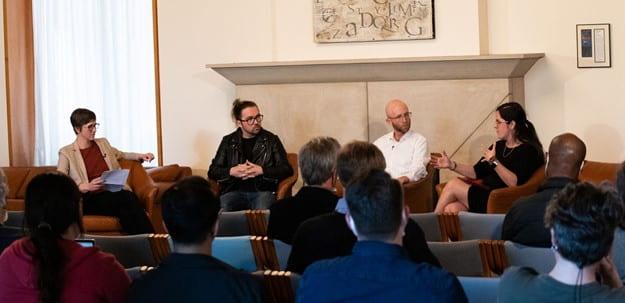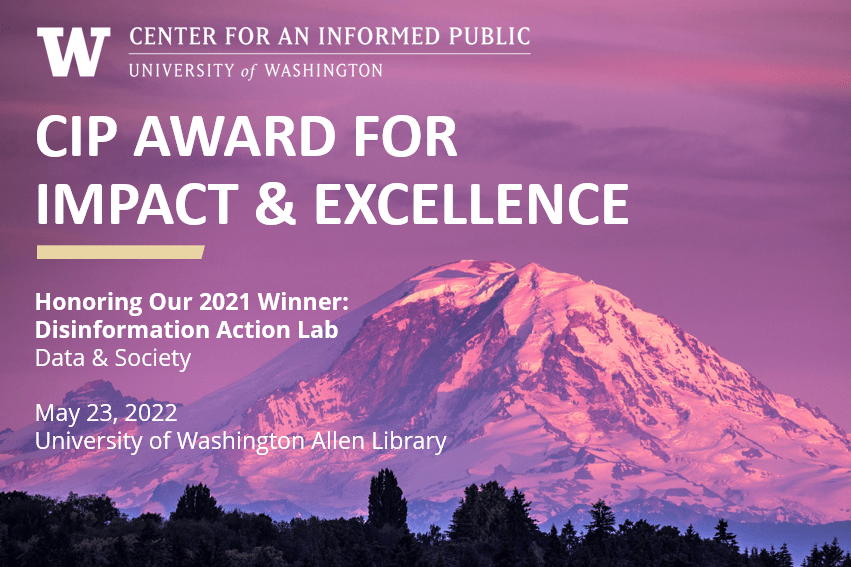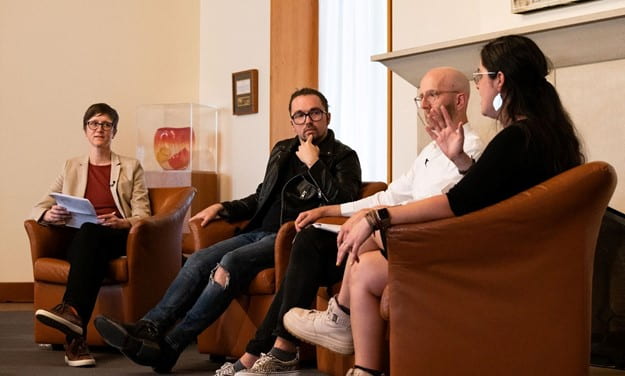During a recent special event at the University of Washington in Seattle, the Center for an Informed Public recognized the accomplishments of a behind-the-scenes networked response to mis- and disinformation about the 2020 U.S. Census, an effort that provides a model for future multi-stakeholder collaborations to mitigate the impacts of communication harms.
Three members involved in the Disinformation Action Lab from Data & Society Research Institute, the winners of the 2021 CIP Award for Impact & Excellence, joined a panel discussion moderated by CIP faculty director Kate Starbird, where they shared insights from their collaboration to protect complete and fair decennial count from mis- and disinformation undermining the public’s confidence in the census.
“When you work in this space, it can often feel like you’re playing a game of whack-a-mole, right? You’re always responding to a problem as it’s happening in real time. And to be clear, if you’re always responding to the problem, you’re going to be behind,” Charley Johnson, DAL’s former program director and the current program director for Data & Society’s Public Tech Leadership Collaborative, said during a May 23 panel discussion hosted in the UW Allen Library’s Petersen Room. “So, two years out, leading up to the census, we had a chance to really develop some proactive strategies to support a network of stakeholders to make a real difference and that was compelling.”
The CIP’s Award for Impact & Excellence honors an individual or organization making outstanding contributions, achievements, or bodies of work that significantly resist strategic misinformation, promote an informed society and strengthen democratic discourse. (A selection committee is currently considering nominations for the 2022 winner, to be announced later this year.)
DAL’s work, which was supported by Johnson, Emma Margolin, Cristina López G., Will Partin, and danah boyd, could not have happened without the contributions and hard work of numerous organizations working as part of the Census Counts Campaign, an effort from The Leadership Conference Education Fund that involved groups like like Asian Americans Advancing Justice | AAJC, National Congress of American Indians, NALEO Educational Fund, the National LGBTQ Task Force, and United We Dream, among others.
Beyond the Census Counts Campaign, DAL supported other national civil rights groups, local civil society groups, state and city government officials, and worked with social media companies, journalists, and the Census Bureau itself — all to protect a complete and fair count from mis- and disinformation.
Despite this assemblage of organizations and stakeholders, very few people outside these stakeholders working on the 2020 Census recognized the vital work they were doing to prepare for mis- and disinformation about the census. And it came at a time when there were other concerns regarding the decennial count, including the COVID-19 pandemic — which was starting to surge in the U.S. by the time the census officially started that April — and possible unforeseen technical challenges in rolling out the bureau’s first digital census.
The panelists said that they hope DAL’s work can serve as a model for future networked collaborations to organize and respond to a whole range of communication threats. In order to capture key lessons and insights and make them useful to organizations in their work, Data & Society is preparing to publish and share a practical guide, “Playbook: A Networked Response to Communication Threats,” by Margolin and López G. That playbook is anticipated for release later this summer.

From left, UW Center for an Informed Public co-founder Kate Starbird (moderator), former DAL research analyst Will Partin and DAL former program director Charley Johnson listen to former DAL senior research analyst Cristina López G. during a May 23 special event in the UW Allen Library’s Petersen Room. (Photos by Doug Parry / UW iSchool)
Supporting census stakeholders and cultivating a networked response
DAL’s work began a few years before the 2020 count.
Since 2015, Data & Society’s work on misinformation and disinformation has helped to define what is now a large and expanding field of study and practice. The organization’s Media Manipulation Initiative investigated attempts to manipulate popular perception through social media, tech platforms, and the changing norms of digital journalism.
Starting in 2017, Data & Society published a number of reports in the area of mis- and disinformation studies. This began with a wide survey of media manipulation trends — Media Manipulation and Disinformation Online — and continued with deeper examinations of specific techniques: Data Voids, Alternative Influence, Source Hacking. Researchers helped identify and define many of the techniques used by those manipulating communication networks to political ends, and proposed interventions — in platform governance, journalistic practice, and community organization — to fight such manipulations.
That helped lay the groundwork for the Disinformation Action Lab, which explored how civil rights groups, journalists, and technology companies might mitigate informational harms to the functions of key democratic institutions, like the 2020 Census.
“Disinformation is a networked problem. We know this from the research, we know this from countless case studies of how harmful narratives spread and scale online. They do so through networks,” Johnson said. “At the same time what we know about how to address disinformation comes from siloed, single-actor-based strategies — what can journalists, tech companies, governments do? To be clear, no single actor can meaningfully address disinformation on their own.”
DAL worked to cultivate and support a network of census stakeholders that included hundreds of organizations — city and state officials, local and national journalists, content creators, state-based Get Out the Count groups, legacy civil rights groups, tech companies of all sizes, and the Census Bureau itself — and helped nurture trust across it.
“This was a giant coalition of partners,” López G., a former DAL senior research analyst now working as a senior analyst at Graphika, said during the panel discussion, noting the need to coordinate effectively in order “to act on behalf of each other when a crisis arises.” In order to start developing these processes, López G. continued, and start “developing almost a muscle memory for what we were going to do in a rapid-response moment, there were a series of activities well before the census that helped us do that.”
In the lead up to the 2020 Census, DAL created 15 different practical guidance documents, including a threat matrix to classify threats and frame appropriate responses, a tip-sheet for journalists on how to report on disinformation, a checklist for verifying content, a guide to reporting problematic content, and a number of case studies.
Johnson continued: “We wanted to work across these different stakeholder groups to, for example, align on a common understanding of the problem, to build out monitoring infrastructure that didn’t just track harmful narratives online but also offline in local communities. We wanted to co-create threat models with the various stakeholders to really get a sense of: What constitutes a threat and from whose perspective? Whether we should respond and if so, how? We wanted to inform one another’s communication strategy, we wanted to share context and decision-making protocols so that we were roughly on the same page about what we were doing. Ultimately, we wanted to learn from one another and adapt along the way.”
Although she couldn’t travel to Seattle for the May 23 event, Beth Lynk, the former director of the Census Counts Campaign at The Leadership Conference Education Fund, said in an email that despite the unprecedented challenges, “the coalition we built and systems we honed allowed for a nimbleness of response that helped prevent harmful misinformation from spreading. The Census Counts campaign included the people and networks who live and work in the communities most at risk of being missed in the census and those who understand the barriers these communities face when being counted.”
When the count began in April 2020, the team monitored mis- and disinformation in parallel to the Census Bureau’s own monitoring efforts, allowing the Bureau and DAL to see what one another was seeing and inform a strategic response.
“As the former Chief Innovation Officer of the U.S. Census Bureau, I can say with certainty that if it weren’t for the DAL team, the U.S. Census Bureau would not have prioritized the problem of disinformation in the way that we did in the lead up to and during the Decennial Census,” Kyla Fullenwider, now a senior advisor for the U.S. Surgeon General, wrote in a CIP Award for Impact & Excellence nomination letter in support of the DAL’s work. “The DAL team raised the profile of the problem within the Bureau but also provided ongoing strategic advice on how to address it, and helped broker relationships with the key stakeholders in the tech community.”
But what constitutes a strategic response isn’t necessarily obvious when it comes to addressing disinformation.
As Whitney Phillips and other scholars have shown, calling attention to a problem gives it oxygen and, thus, helps it flourish. The DAL team supported census stakeholders in determining whether and how to respond to a potential threat, while minimizing the likelihood of amplification.
When there was a problematic incident involving census-related mis- and disinformation, “Census stakeholders, myself included, understandably wanted to call out the threat to protect hard to count communities,” Denice Ross, who is now serving in the White House as the U.S. Chief Data Scientist, wrote in a nomination letter when she was a senior fellow at the National Conference on Citizenship.
Ross, who previously chaired Georgetown University’s Census Quality Reinforcement group, continued: “The DAL team — by developing practical materials and running interactive learning exercises — helped stakeholders make strategic decisions about whether to engage having internalized the problem of amplification.”
Over the course of their two-year program, the DAL team organized 46 learning events — including webinars, workshops, scenario planning exercises — across the U.S.
DAL created four different analog tabletop simulations so that different stakeholders could practice responding in the context of an evolving disinformation campaign. DAL then ran this simulation six times, putting different stakeholders in conversation with each other — city officials, journalists, local community groups, tech platforms, the Census Bureau, civil rights and other civil society organizations.
“DAL’s approach to ongoing engagement and capacity building was among the best examples I’ve ever seen of a technical team serving a larger people-based movement toward the betterment of society,” Ross wrote.

Lessons and legacy
Ultimately, DAL’s team of researchers discovered that mis- and disinformation did not become the prominent threats to census work that was once feared.
“One of our interesting findings was that while we certainly found what seemed clearly like hostile influence operations, they actually in some ways were the minority in the broader range of threats that we saw,” former DAL analyst Will Partin, currently an affiliated researcher with the University of North Carolina’s Center for Information, Technology and Public Life, said during the panel discussion.
Partin pointed to an example involving a public service announcement featuring actor Morgan Freeman promoting the census which included a stock QR code that when scanned, took you to “a Chinese language app in the depths of the Google Play store. This wasn’t disinformation in any sort of meaningful sense,” but “nevertheless had a similar impact” in undermining trust in the process. Partin described the Morgan Freeman PSA QR code incident as a “transformative moment” in understanding the scope of the challenges. “What we’re looking for is not capital-D disinfo. We’re starting with the impacts and then thinking about the kinds of content that can lead to that impact.”
Instead, López G. noted, the largest communication challenges emerged from the reality of missing information, from differences in defining “fairness” and “accuracy,” and from the complicated social realities of coalition work at the national scale.
What’s next
Data & Society’s work on mis- and disinformation has helped to define what is now a large and expanding field of study and practice. Today, the field the organization helped launch is increasingly robust, and many of the concepts from early research have become mainstream ideas. While DAL’s work focused explicitly on addressing mis- and disinformation, researchers said that the experience working with the census coalition made clear just how dire other forms of communication threats can be.
“This work in the mis- and disinformation space has tended to focus on what’s untrustworthy,” Johnson said. “As this work winds down, we’re excited to turn our attention to what is trustworthy” and building upon lessons of what worked well with DAL’s approach and what didn’t, Johnson added.
Data & Society’s emerging Trustworthy Infrastructures program, led by Sareeta Amrute, who joined Data & Society from UW and exploring this topic on a Russell Sage fellowship, will build on the lessons of DAL as the organization pivots to consider what it looks like and what’s made possible when communities have trust in each other and in the online infrastructures they use.
Under this new program, Data & Society is seeking to understand not only how the disinformation framework upholds existing power dynamics, but what minoritized communities are doing to invent and uphold their own structures of communication.
“We want to understand what it looks like and what is possible when communities trust one another,” Johnson said.
The work of the Disinformation Action Lab at Data & Society was made possible with generous support from the William and Flora Hewlett Foundation, the John S. and James L. Knight Foundation, Craig Newmark Philanthropies, Ford Foundation, Alfred P. Sloan Foundation, National Conference on Citizenship (NCOC), Patrick J. McGovern Foundation, and the Media Democracy Fund.



